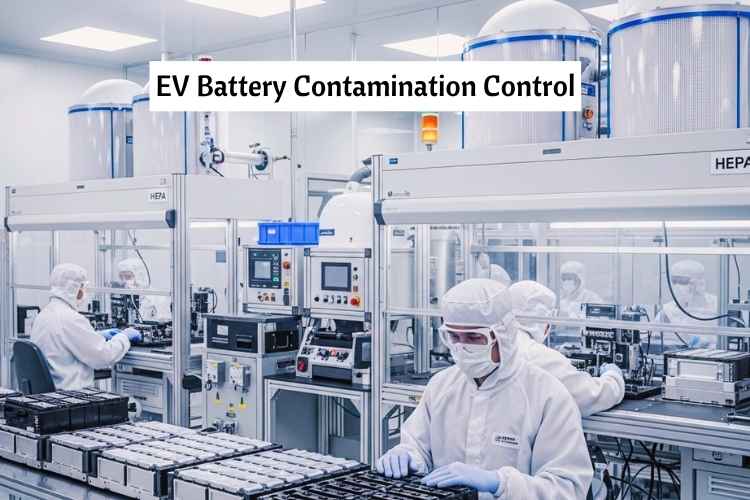EV Battery Contamination Control: Electric Vehicles (EVs) are revolutionising transportation, but behind every high-performance EV is a powerful, precisely engineered lithium-ion battery. These batteries must be manufactured under tightly controlled conditions, especially concerning contamination. A single microscopic particle can cause short circuits, reduce battery life, or lead to safety hazards like thermal runaway.
This article will walk you through why contamination control is essential, how Meech’s technology works, and how these solutions are helping leading EV manufacturers optimise quality and productivity.

Table of Contents
The Importance of EV Battery Contamination Control in Manufacturing
Contamination may sound like a minor issue, but in EV battery production, it’s a major concern. These batteries contain sensitive components like separators, electrodes, and electrolyte solutions. Any contamination—be it dust, fibres, or static charges—can cause:
- Microscopic defects in the cell
- Compromised insulation, leading to short circuits
- Reduced battery efficiency or lifespan
- Safety risks, including overheating or fires
According to the Battery Innovation Centre, even particles as small as 10 microns (1/10th the diameter of a human hair) can degrade performance or cause catastrophic failure.
EV manufacturers are investing heavily in cleanroom facilities, but static charges and in-process contamination often persist. That’s where Meech’s proactive solutions become essential.
Static Control: EV Battery Contamination Control
Static electricity is an invisible but potent issue in battery production. When materials like film, foil, or separators move quickly through the manufacturing line, they generate static. This static charge:
- Attracts dust and fibres
- Disrupts automation equipment
- Creates handling hazards for delicate materials
Meech’s solution? Ionising bars.
Meech’s Hyperion range of static control bars neutralises static by releasing balanced ions into the air. These ions cancel out the surface charge on materials, preventing particles from sticking.
ROI: The Business Case for Meech Systems
You might wonder: Is investing in static and contamination control Meech systems worth it?
Short answer: absolutely.
| Metric | Benefit |
|---|---|
| Fewer product defects | Better yields, less scrap |
| Reduced downtime | Higher throughput |
| Improved worker safety | Fewer electrostatic incidents |
| Compliance with quality standards | Easier certifications (ISO, IATF) |
Quick Summary Table: Meech Strategies for EV Battery Contamination Control
| Strategy | Description | Benefit |
|---|---|---|
| Ionizing Bars | Ionised air and vacuum | Prevents particle attraction, protects equipment |
| Contact Web Cleaners | Brushes/rollers remove particles | Ideal for robust materials |
| Non-Contact Cleaners | Monitors ionisation levels | Gentle on sensitive films |
| SmartControl Systems | Monitors ionization levels | Enables real-time adjustments |
| Cleanroom Integration | Industry 4.0 ready | Ensures compliance, traceability |
Conclusion
EV battery production demands precision, cleanliness, and control. A single contaminant or static charge can make the difference between a reliable battery and a failed one. That’s why Meech’s static control and web cleaning solutions are vital tools in the modern battery factory.
Whether you’re scaling up production, aiming for higher yields, or targeting cleaner processes, integrating Meech’s proven technologies is a smart investment. Not only do they protect the integrity of each cell, but they also drive real business results through cost savings, efficiency gains, and improved product reliability.
Bhakti Rawat is a Founder & Writer of InsureMyCar360.com. This site Provides You with Information Related To the Best Auto Insurance Updates & comparisons. 🔗
